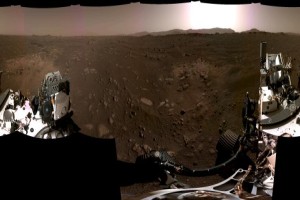
Florida: NASA’s Mars 2020 Perseverance rover got its first high-definition look around its new home in Jezero Crater on February 21, 2021 after rotating its mast, or “head,” 360 degrees, allowing the rover’s Mastcam-Z instrument to capture its first panorama after touching down on the Red Planet on February 18. It was the rover’s second panorama ever, as the rover’s Navigation Cameras, or Navcams, also located on the mast, captured a 360-degree view on February 20.

Mastcam-Z is a dual-camera system equipped with a zoom function, allowing the cameras to zoom in, focus, and take high-definition video, as well as panoramic colour and 3D images of the Martian surface. With this capability, the robotic astrobiologist can provide a detailed examination of both close and distant objects.
Also read:
- NASA’s Mars Perseverance Rover safely lands and sends first images from Red Planet
- NASA makes arrangements for live coverage of Perseverance rover’s landing on Mars tonight (IST)
The cameras will help scientists assess the geologic history and atmospheric conditions of Jezero Crater and will assist in identifying rocks and sediment worthy of a closer look by the rover’s other instruments. The cameras also will help the mission team determine which rocks the rover should sample and collect for eventual return to Earth in the future.

Stitched together from 142 images, the newly released panorama reveals the crater rim and cliff face of an ancient river delta in the distance. The camera system can reveal details as small as 0.1 to 0.2 inches (3 to 5 millimeters) across near the rover and 6.5 to 10 feet (2 to 3 meters) across in the distant slopes along the horizon.
The detailed composite image shows a Martian surface that appears similar to images captured by previous NASA rover missions.
“We’re nestled right in a sweet spot, where you can see different features similar in many ways to features found by Spirit, Opportunity, and Curiosity at their landing sites,” said Jim Bell of Arizona State University’s School of Earth and Space Exploration, the instrument’s principal investigator. ASU leads operations of the Mastcam-Z instrument, working in collaboration with Malin Space Science Systems in San Diego.
The camera team will discuss the new panorama during a question and answer session at 4 p.m. EST Thursday, February 25, which will air live on NASA Television and the agency’s website.
Mastcam-Z’s design is an evolution of NASA’s Curiosity Mars rover’s Mastcam instrument, which has two cameras of fixed focal length rather than zoomable cameras. The two cameras on Perseverance’s Mastcam-Z dual cameras are mounted on the rover’s mast at eye level for a person 6 feet, 6 inches (2 meters) tall. They sit 9.5 inches (24.1 centimeters) apart to provide stereo vision and can produce color images with a quality similar to that of a consumer digital HD camera.
The Mastcam-Z team includes dozens of scientists, engineers, operations specialists, managers, and students from a variety of institutions. In addition, the team includes deputy principal investigator Justin Maki of NASA’s Jet Propulsion Laboratory in Southern California.
New video from NASA’s Mars 2020 Perseverance rover chronicles major milestones during the final minutes of its entry, descent, and landing (EDL) on the Red Planet on Feb. 18 as the spacecraft plummeted, parachuted, and rocketed toward the surface of Mars. A microphone on the rover also has provided the first audio recording of sounds from Mars.
From the moment of parachute inflation, the camera system covers the entirety of the descent process, showing some of the rover’s intense ride to Mars’ Jezero Crater. The footage from high-definition cameras aboard the spacecraft starts 7 miles (11 kilometers) above the surface, showing the supersonic deployment of the most massive parachute ever sent to another world, and ends with the rover’s touchdown in the crater.
Sounds From Mars: Includes Rover Self-Noise
Sounds From Mars: Filters Out Rover Self-Noise
A microphone attached to the rover did not collect usable data during the descent, but the commercial off-the-shelf device survived the highly dynamic descent to the surface and obtained sounds from Jezero Crater on Feb. 20. About 10 seconds into the 60-second recording, a Martian breeze is audible for a few seconds, as are mechanical sounds of the rover operating on the surface.
“For those who wonder how you land on Mars – or why it is so difficult – or how cool it would be to do so – you need look no further,” said acting NASA Administrator Steve Jurczyk. “Perseverance is just getting started, and already has provided some of the most iconic visuals in space exploration history. It reinforces the remarkable level of engineering and precision that is required to build and fly a vehicle to the Red Planet.
NASA’s Mars 2020 Perseverance mission captured thrilling footage of its rover landing in Mars’ Jezero Crater on Feb. 18, 2021. The real footage in this video was captured by several cameras that are part of the rover’s entry, descent, and landing suite. The views include a camera looking down from the spacecraft’s descent stage (a kind of rocket-powered jet pack that helps fly the rover to its landing site), a camera on the rover looking up at the descent stage, a camera on the top of the aeroshell (a capsule protecting the rover) looking up at that parachute, and a camera on the bottom of the rover looking down at the Martian surface. The audio embedded in the video comes from the mission control call-outs during entry, descent, and landing.
Credits: NASA/JPL-Caltech
– global bihari bureau






Amazing👍 great achievement